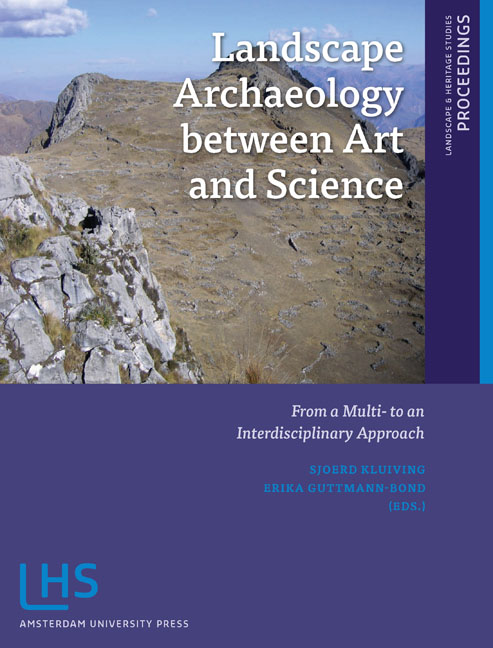Book contents
- Frontmatter
- Contents
- Preface
- Introduction: LAC2010: First International Landscape Archaeology Conference
- THEME 1 HOW DID LANDSCAPE CHANGE?
- THEME II IMPROVING TEMPORAL, CHRONOLOGICAL AND TRANSFORMATIONAL FRAMEWORKS
- THEME III LINKING LANDSCAPES OF LOWLANDS TO MOUNTAINOUS AREAS
- THEME IV APPLYING CONCEPTS OF SCALE
- THEME V NEW DIRECTIONS IN DIGITAL PROSPECTION AND MODELLING TECHNIQUES
- THEME VI HOW WILL LANDSCAPE ARCHAEOLOGY DEVELOP IN THE FUTURE?
- Miscellaneous Endmatter
5.8 - Modelling the Agricultural Potential of Early Iron Age Settlement Hinterland areas in Southern Germany
Published online by Cambridge University Press: 21 January 2021
- Frontmatter
- Contents
- Preface
- Introduction: LAC2010: First International Landscape Archaeology Conference
- THEME 1 HOW DID LANDSCAPE CHANGE?
- THEME II IMPROVING TEMPORAL, CHRONOLOGICAL AND TRANSFORMATIONAL FRAMEWORKS
- THEME III LINKING LANDSCAPES OF LOWLANDS TO MOUNTAINOUS AREAS
- THEME IV APPLYING CONCEPTS OF SCALE
- THEME V NEW DIRECTIONS IN DIGITAL PROSPECTION AND MODELLING TECHNIQUES
- THEME VI HOW WILL LANDSCAPE ARCHAEOLOGY DEVELOP IN THE FUTURE?
- Miscellaneous Endmatter
Summary
ABSTRACT
Agriculture was the main basis of daily life in most prehistoric periods in Europe. The possibility of a settlement to produce more than the basic needs in a subsistence economy was in many cases the background of a surplus-based superiority of some settlements over others.
In our paper we will present a GIS and database system with which we model the agricultural potential of settlements within their natural surroundings based on topography and soil quality. Within the framework of the research project ‘Early Centralisation and Urbanisation – The Genesis and Development of Early Celtic Princely Sites and their Territorial Surrounding’ (http://www.fuerstensitze.de) we have developed a model which is used to calculate the maximum amount of people that can be fed from within the hinterland of both princely sites and ‘regular’ settlements by cattle and crop. The surrounding itself can be defined by cost-based calculations, creating a hinterland border based on walking time. The model is then used to compare the agricultural potential of different settlement sites as well as of sites from different periods.
It is the aim of our working group to further develop a runtime database file, which can be used to model the agricultural potential from any given archaeological site within a given surrounding and to calculate the amount of people that can be nourished from this hinterland. The database file will be distributed online as free software.
KEYWORDS
GIS analyses, agricultural potential, hinterland, cost distance, calorie expenditure
INTRODUCTION
The project ‘Princely Sites’ & Environs (‘Fürstensitze” & Umland, funded by the German Research Foundation within the framework of the Priority Programme ‘Early Processes of Centralisation and Urbanisation – Studies on the Development of Early Celtic Princely Seats and their Hinterland’, http://www.fuerstensitze. de) is investigating the so-called ‘Princely Sites’ or ‘Fürstensitze’ of the Early Iron Age around 500 BC in south-western Germany, eastern France and comparable places in Bavaria and western Bohemia (http:// www.fuerstensitze.de/1121).
Following a definition mainly described by W. Kimmig (1969), ‘Fürstensitze’ are rich fortified settlements, mainly situated on a hilltop, with large and rich grave mounds in their vicinity and with finds of imported goods, mainly ceramics from the Mediterranean. They seem to be the result of a social and maybe even cultural change or transformation of the protoceltic societies which we still do not understand to its full extent (cf. Schier 1998).
- Type
- Chapter
- Information
- Landscape Archaeology between Art and ScienceFrom a Multi- to an Interdisciplinary Approach, pp. 413 - 428Publisher: Amsterdam University PressPrint publication year: 2012



